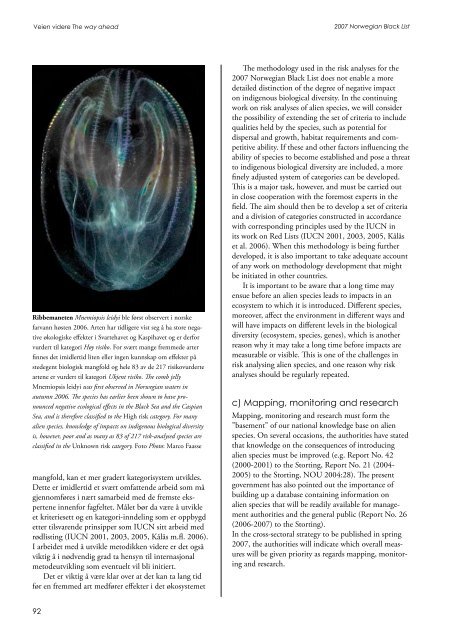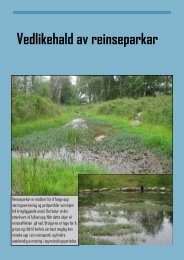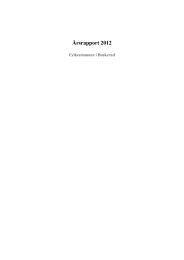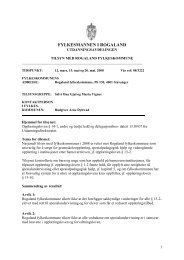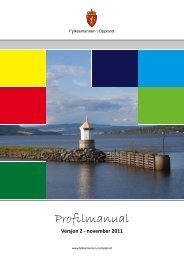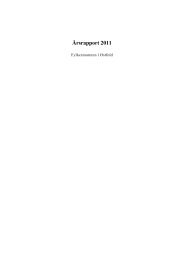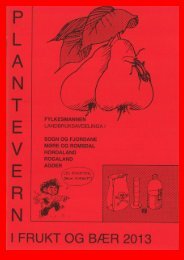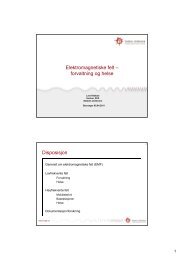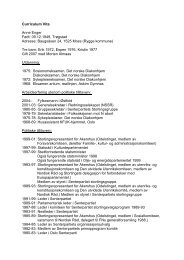Norsk svarteliste 2007
Last ned Norsk svarteliste 2007 - Artsdatabanken
Last ned Norsk svarteliste 2007 - Artsdatabanken
Create successful ePaper yourself
Turn your PDF publications into a flip-book with our unique Google optimized e-Paper software.
Veien videre The way ahead<br />
<strong>2007</strong> Norwegian Black List<br />
Ribbemaneten Mnemiopsis leidyi ble først observert i norske<br />
farvann høsten 2006. Arten har tidligere vist seg å ha store negative<br />
økologiske effekter i Svartehavet og Kaspihavet og er derfor<br />
vurdert til kategori Høy risiko. For svært mange fremmede arter<br />
finnes det imidlertid liten eller ingen kunnskap om effekter på<br />
stedegent biologisk mangfold og hele 83 av de 217 risikovurderte<br />
artene er vurdert til kategori Ukjent risiko. The comb jelly<br />
Mnemiopsis leidyi was first observed in Norwegian waters in<br />
autumn 2006. The species has earlier been shown to have pronounced<br />
negative ecological effects in the Black Sea and the Caspian<br />
Sea, and is therefore classified to the High risk category. For many<br />
alien species, knowledge of impacts on indigenous biological diversity<br />
is, however, poor and as many as 83 of 217 risk-analysed species are<br />
classified in the Unknown risk category. Foto Photo: Marco Faasse<br />
mangfold, kan et mer gradert kategorisystem utvikles.<br />
Dette er imidlertid et svært omfattende arbeid som må<br />
gjennomføres i nært samarbeid med de fremste ekspertene<br />
innenfor fagfeltet. Målet bør da være å utvikle<br />
et kriteriesett og en kategori-inndeling som er oppbygd<br />
etter tilsvarende prinsipper som IUCN sitt arbeid med<br />
rødlisting (IUCN 2001, 2003, 2005, Kålås m.fl. 2006).<br />
I arbeidet med å utvikle metodikken videre er det også<br />
viktig å i nødvendig grad ta hensyn til internasjonal<br />
metodeutvikling som eventuelt vil bli initiert.<br />
Det er viktig å være klar over at det kan ta lang tid<br />
før en fremmed art medfører effekter i det økosystemet<br />
The methodology used in the risk analyses for the<br />
<strong>2007</strong> Norwegian Black List does not enable a more<br />
detailed distinction of the degree of negative impact<br />
on indigenous biological diversity. In the continuing<br />
work on risk analyses of alien species, we will consider<br />
the possibility of extending the set of criteria to include<br />
qualities held by the species, such as potential for<br />
dispersal and growth, habitat requirements and competitive<br />
ability. If these and other factors influencing the<br />
ability of species to become established and pose a threat<br />
to indigenous biological diversity are included, a more<br />
finely adjusted system of categories can be developed.<br />
This is a major task, however, and must be carried out<br />
in close cooperation with the foremost experts in the<br />
field. The aim should then be to develop a set of criteria<br />
and a division of categories constructed in accordance<br />
with corresponding principles used by the IUCN in<br />
its work on Red Lists (IUCN 2001, 2003, 2005, Kålås<br />
et al. 2006). When this methodology is being further<br />
developed, it is also important to take adequate account<br />
of any work on methodology development that might<br />
be initiated in other countries.<br />
It is important to be aware that a long time may<br />
ensue before an alien species leads to impacts in an<br />
ecosystem to which it is introduced. Different species,<br />
moreover, affect the environment in different ways and<br />
will have impacts on different levels in the biological<br />
diversity (ecosystem, species, genes), which is another<br />
reason why it may take a long time before impacts are<br />
measurable or visible. This is one of the challenges in<br />
risk analysing alien species, and one reason why risk<br />
analyses should be regularly repeated.<br />
c) Mapping, monitoring and research<br />
Mapping, monitoring and research must form the<br />
”basement” of our national knowledge base on alien<br />
species. On several occasions, the authorities have stated<br />
that knowledge on the consequences of introducing<br />
alien species must be improved (e.g. Report No. 42<br />
(2000-2001) to the Storting, Report No. 21 (2004-<br />
2005) to the Storting, NOU 2004:28). The present<br />
government has also pointed out the importance of<br />
building up a database containing information on<br />
alien species that will be readily available for management<br />
authorities and the general public (Report No. 26<br />
(2006-<strong>2007</strong>) to the Storting).<br />
In the cross-sectoral strategy to be published in spring<br />
<strong>2007</strong>, the authorities will indicate which overall measures<br />
will be given priority as regards mapping, monitoring<br />
and research.<br />
92


